The International Clarinet Association at 50: A Complete History (1973-2023)
Celebrating five decades of fostering clarinet excellence worldwide
Origins and Foundations (1973-1992)
Refining the Mission (1992-2002)
Continuity and Change (2002-2012)
Challenges, Resilience, and Growth (2012-2023)
Legacy and Future (2024-)
Origins and Foundations (1973-1992)
The International Clarinet Association traces its origins to the National Clarinet Clinic at the University of Denver, which began in 1964 under Ralph Strouf’s visionary leadership. By 1973, this annual gathering had evolved into the International Clarinet Clinic (ICC) under Ramon Kireilis, featuring renowned artists like Leon Russianoff, Vincent Abato, Karl Leister, and Gervase de Peyer.
The transformative moment came in 1973 when Kireilis proposed creating the International Clarinet Society (ICS) as a separate organization that would hold its annual meeting during the ICC. The founding officers were:
- President: Ramon Kireilis
- Vice-President: Leon Russianoff
- Secretary-Treasurer: Robert Schott (Kansas State College)
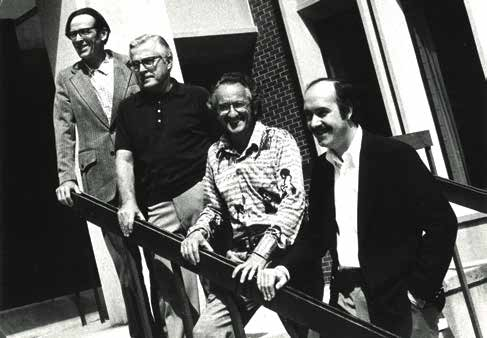
(Left to right) Lee Gibson, Robert Schott, Leon Russianoff, and Ramon Kireilis at an early Denver clinic (c. 1973)
O. Lee Gibson, named the first editor of The Clarinet journal, outlined the organization’s ambitious founding goals:
- Foster worldwide communication among clarinetists
- Encourage composition of new clarinet works through commissions
- Establish an international clarinet library
- Provide comprehensive clarinet music catalogs
- Share knowledge of diverse clarinet traditions globally
The organization quickly gained momentum. By 1974, membership approached 800, and a formal constitution was adopted. The ICS incorporated in 1975 and achieved tax-exempt status in 1978—a banner year that saw Lee Gibson become the second president and James Gillespie take over as journal editor, a position he would hold for an extraordinary 37 years.
The 1978 ICC marked a historic milestone as the first held outside the United States, taking place in Toronto under Avrahm Galper’s direction. This established the precedent for international conferences, with future events in Paris (1981) and London (1984).
During Jerry Pierce’s presidency (1980-86), the organization continued its international growth. The emergence of ClariNetwork InterNational in 1982 initially created some division, as it sought to serve symphony clarinetists and East Coast members who felt underrepresented. However, this challenge ultimately strengthened the organization when the two groups merged in 1988, becoming the International Clarinet Society/ClariNetwork InterNational (ICS/CI).
Charles West’s presidency (1988-1992) brought crucial administrative improvements, including membership brochures, better ClarinetFest planning (conferences now selected two years in advance), and the biennial commissioning format. The organization’s name was simplified to the International Clarinet Association (ICA) in 1991, chosen by membership vote over “Clarinet International.”
By 1992, the ICA had grown from 800 to nearly 3,000 members, establishing itself as a thriving international organization with a solid foundation for future growth.
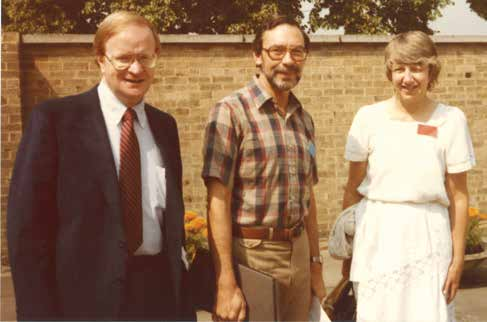
James Gillespie, Dan Sparks, and Thea King in Paris for the 1981 International Clarinet Congress
Refining the Mission (1992-2002)
The 1990s marked a period of mission refinement under President Howard Klug (1992-1994), who declared himself “the education president.” His administration introduced significant structural changes:
- Split the single competition into separate high school (age 19) and young artist (age 26) competitions
- Created the composition competition, managed by Michele Gingras
- Launched the Adopt-A-Member program for accessibility
- Emphasized local clarinet clubs and community outreach
The ICA embraced emerging technology during this decade. In 1992, an information service called Klarinet was established using Bitnet, predating the World Wide Web. By 1995, President Gerry Errante was encouraging members to enter the “information superhighway,” and the organization appointed its first internet liaison.
Under Alan Stanek’s presidency (1996-1998), the ICA launched its first website with Stan Geidel as webmaster. This digital presence immediately helped increase membership, which reached nearly 3,900 by mid-term, including significant international growth.
Robert Spring (1998-2000) oversaw crucial improvements to the annual conference structure:
- Updated conference handbook with clearer host responsibilities
- Created the exhibition coordinator position (first filled by Gary Whitman)
- Established criteria for Honorary Membership Awards
- Moved toward hotel and convention center venues for larger attendance
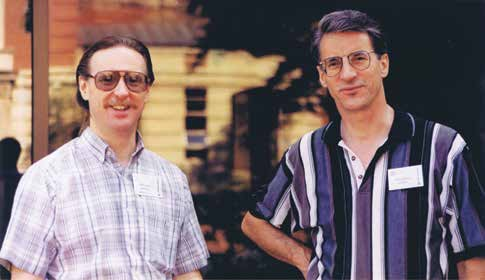
Then-president of the ICA, Robert Spring, and past president Charles West at ClarinetFest® 1998 in Columbus, Ohio
Julie DeRoche became the ICA’s first female president (2000-2002), implementing significant business improvements:
- New accounting systems for better financial management
- $5,000 support allocation for ClarinetFest hosts
- Development of online membership renewal capabilities
- Creation of international liaison positions
- Introduction of member grants program
During this period, membership approached 4,000, and the organization achieved greater operational sophistication while maintaining its core mission of serving clarinetists worldwide.
Continuity and Change (2002-2012)
President Robert Walzel (2002-2004) made the pivotal decision to hire the organization’s first executive director, with Rose Sperrazza (formerly membership coordinator) filling this crucial role. This professionalization allowed the ICA to manage its growing complexity more effectively while supporting an increasingly ambitious annual conference program.
Key innovations during this period included:
- Online membership services launch
- Three international liaison positions
- First ICA grants program awards
- Major commission (Michael Daugherty’s Brooklyn Bridge)
- Annual $1,500 contribution to the ICA Research Library
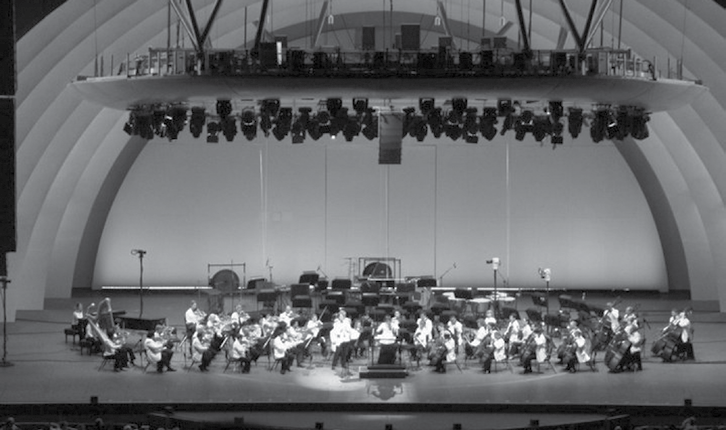
The Los Angeles Philharmonic in concert at the Hollywood Bowl, ClarinetFest® 2011
Lee Livengood (2005-2008) focused on revitalizing the state chair system and modernizing operations. Website capabilities expanded to include competition and ClarinetFest registration, while membership structure became more flexible with quarterly renewals and two-year options.
Gary Whitman’s presidency (2008-2010) brought important partnerships, including collaboration with peer organizations on a wind quintet commission (Lansing McLoskey’s Hardwood) and revival of the composition competition. The organization also embraced social media, launching its Facebook page in 2009.
Keith Koons (2010-2012) oversaw significant digital developments, such as:
- Past issues of The Clarinet made available online in PDF format
- Electronic newsletter implementation
- International Access Initiative for global outreach
- Enhanced donation capabilities through the website
This decade featured memorable conferences including the first ClarinetFest in Asia with the Tokyo (2005) Festival, which introduced excellent Asian artists and unique cultural experiences. The Porto conference (2009) delighted audiences with the theatrical “Show des Vents,” while Los Angeles (2011) featured Indian clarinet music and a concert at the Hollywood Bowl.
Membership remained stable around 4,000 throughout this period, with the organization achieving operational maturity and financial stability while expanding its global reach and digital capabilities.
Challenges, Resilience, and Growth (2012-2023)
The ICA’s most recent decade has been marked by significant challenges that tested the organization’s resilience. From 2012-2018, membership saw a concerning 25% decrease that demanded immediate attention.
The organization faced concurrent financial difficulties, due to both falling membership revenue and costly experiments with outside management companies. However, through data-driven decision-making and careful financial reforms led by Treasurer Tod Kerstetter, the ICA implemented crucial changes:
- Returned to the more cost-effective executive director model
- Streamlined business practices and reduced operational costs
- Found less expensive printing solutions for The Clarinet
- Implemented new revenue streams and sponsorship tiers
The membership crisis sparked innovative solutions, particularly in international outreach. The conversion of the international chair to an appointed board representative position (filled initially by Stephan Vermeersch) began a restructuring that would prove transformational.
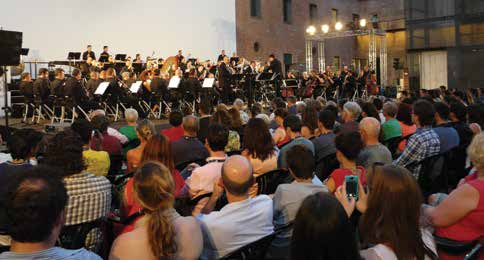
At ClarinetFest® 2015 in Madrid; the Buffet-Vandoren-D’Addario Gala Concert featuring the Banda Sinfónica Municipal de Madrid
Key developments included:
- Creation of the international relations chair (Luca Sarraca, 2018)
- Addition of continent chairs alongside country chairs
- Elevation of international representative to full board position (International Vice President, filled by Eddy Vanoosthuyse in 2020)
- Partner memberships with international clarinet organizations
These efforts proved remarkably successful. International members now constitute nearly half of the ICA’s total membership, representing a complete transformation of the organization’s global character.
President Maxine Ramey (2014-2015) made engaging clarinetists aged 18-30 a central priority, establishing strategies that subsequent presidents expanded:
- Enhanced social media presence and The Clarinet [Online] blog
- Youth committee formation to research better service approaches
- Student travel grant program (2018)
- Middle school and high school membership categories
- Free conference days for young students
At ClarinetFest 2019 in Knoxville, Tennessee, the ICA became the Guinness World Record holder for largest clarinet ensemble with 367 members, led by Mitchell Estrin, a record that has yet to be broken, despite several attempts around the world. This was a crowning moment in a particularly successful and well-attended ClarinetFest conference.
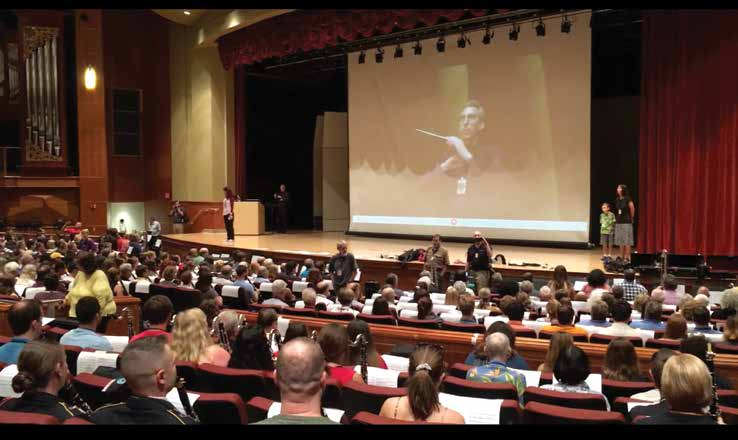
Mitchell Estrin conducting the largest ever clarinet choir (367 members) at ClarinetFest® 2019 in Knoxville, achieving a new Guinness World Record
However, the COVID-19 pandemic presented an unprecedented challenge when ClarinetFest 2020 in Reno, Nevada required cancellation. The ICA demonstrated remarkable adaptability by bringing together digital events that gave people an opportunity to gather and share music even during the height of the pandemic.
“The ICA Plays On” (2020): Executive Director Jessica Harrie and Social Media Coordinator Jenny Maclay created a successful online conference featuring interviews and panel discussions on topics from extended techniques to adult enthusiast programs.
Virtual ClarinetFest 2021: The entire conference moved online with exceptional success, including the Clarinet Learning Community and Showcase Stage for younger performers.
Even post-pandemic, online programming has continued with New Music Weekends, Clareidoscope, Together Again events, and the increasingly popular Low Clarinet Festival (2023 and 2025).
The Clarinet underwent significant changes when Rachel Yoder succeeded James Gillespie as editor in 2015. Major improvements included:
- Full-color printing for the first time
- Editorial board establishment for scholarly rigor
- New columns like “International Spotlight” and “Clarinet Chronicles”
- Complete digitization of all back issues (James Gillespie Library)
- Transition to electronic delivery beginning 2023
The organization made significant strides in representation and inclusion:
- Four female presidents in the last ten years (compared to one in the first 40)
- Female participation in ClarinetFest performances increased from 11% (1981) to 48.3% (2022)
- Creation of Diversity, Equity, Inclusion, and Access Committee
- ICA Legends award established to honor deceased luminaries
- Enhanced accessibility programs and reduced-rate memberships
The ICA’s resilience proved extraordinary. By ClarinetFest 2022 in Reno, membership reached an all-time high of 4,497, including 2,302 US members and 2,195 international members. Financial health recovered from a low of $13,000 (2015) to over $110,000 (2022).
Legacy and Future (2024-)
Fifty years after its founding, the International Clarinet Association stands as a testament to the vision of its founders and the dedication of thousands of volunteers, members, and supporters. From Ramon Kireilis’s initial proposal to today’s global organization, the ICA has:
- Grown from 800 to over 4,400 members worldwide
- Commissioned hundreds of new works for clarinet
- Published over 200 issues of The Clarinet journal
- Hosted 50 annual conferences on multiple continents
- Established comprehensive research and educational resources
- Created pathways for countless careers and friendships
The ICA’s greatest strength lies in its people—board members, national and state chairs, coordinators, editors, ClarinetFest teams, volunteers, and members from every corner of the globe. They represent diverse cultures, backgrounds, identities, ages, and perspectives, united by their shared love of the clarinet. This diversity is the organization’s greatest asset. As the ICA continues evolving to meet changing needs and embrace new opportunities, it does so with the confidence that comes from five decades of successful adaptation and growth. With robust international membership, innovative programming, financial stability, and an unwavering commitment to inclusivity and excellence, the International Clarinet Association is positioned to continue fostering clarinet artistry and community for generations to come.
This history is based on the four-part series by Jane Ellsworth published in The Clarinet magazine, volumes 50-51 (2022-2023), celebrating the ICA’s 50th anniversary. The International Clarinet Association continues to serve clarinetists worldwide through ClarinetFest, The Clarinet journal, competitions, commissions, and educational programs.